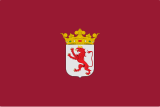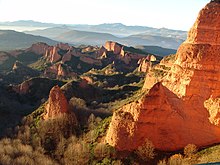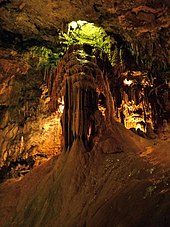Province of León
|
León, Castile and Leon , Spain |
|
|---|---|
 coat of arms |
 flag |
| Designations | |
| Spanish name : | Leon |
| Leonese name : | Llion |
| Basic data | |
| Autonomous Community : | Castile and Leon |
| Capital : | Leon |
| Official language : | Spanish |
| Area : | 15,582 km² |
| Residents : | 460.001 (Jan 1, 2019) |
| Population density : | 29.52 inhabitants / km² |
| ISO 3166-2 : | ES-LE |
| Website : | dipuleon.es |
| Location of the province of León | |
The province of León ( leonesisch : Llion ) is a province in the northwest of Spain . It has 460,001 inhabitants (2019) and belongs to the autonomous region of Castile-León . The capital and largest city is León , the second largest city is Ponferrada .
In the north the province borders on Asturias and Cantabria , in the west on the Galicia region , in the south on Zamora and Valladolid and in the east on Palencia . It has an area of 15,581.81 km². In the very scenic province, located between the mountains of northern Spain and the plateau, there are various natural parks ( Parque nacional de los Picos de Europa , Los Ancares , the area around the former open-cast mine Las Médulas and the Cueva de Valporquero cave ).
history
The province of León was created in 1833 as part of the territorial reform initiated by Francisco Javier de Burgos . It was made up of the regions of León, Salamanca and Zamora . Until 1933, the independently administered Kingdom of Leon , which stretched over the northwestern part of the Iberian Peninsula, retained the status of a kingdom, although it was already subject to the Crown of Castile. The kingdom of Leon was founded in 910 AD when the Christian rulers of Asturias moved their capital from Oviedeo to León . The Atlantic provinces declared themselves independent in 1139. The Kingdom of Portugal emerged from them . In 1188, the Kingdom of Leon developed a parliament, which UNESCO describes as the first parliament in Europe.
language
In some areas of Léon, Leonese is spoken, an ancient dialect which, together with Asturian, forms a transition between Galician - Portuguese and actual Castilian (Spanish).
Population development of the province

When the Moors withdrew in the 9th century, the region was largely depopulated and only gradually repopulated. Since the 1960s, the mechanization and loss of importance of agriculture have again led to a population decline. With that, many regional traditions disappeared.
Largest cities and towns
(As of January 1, 2019)
| local community | Residents |
|---|---|
| Leon | 124.303 |
| Ponferrada | 64,674 |
| San Andrés del Rabanedo | 30,615 |
| Villaquilambre | 18,638 |
| La Bañeza | 10,338 |
| Astorga | 10,867 |
| Villablino | 8,620 |
| Bembibre | 8,705 |
| Valverde de la Virgen | 7,328 |
| Fabero | 4,493 |
| Cacabelos | 5.118 |
Culture
The Ruta de la Plata (Silver Road, an old Roman road) leads through the province in north-south direction and the Way of St. James (Spanish Camino de Santiago ) in east-west direction . The cathedral of Léon was a highlight of the Camino de Santiago. From a culinary point of view, air-dried sausage specialties ( embutidos ) and the wines of Bierzo and Valdevimbre-Los Oteros should be mentioned.
The regional political and cultural movement of Leonesismo , which demands more autonomy within the borders of the old kingdom of Léon, but also supports folklore, Leonese courses and regional gastronomy, has an impact beyond the province of Léon .
See also
Web links
Individual evidence
- ↑ Cifras oficiales de población resultantes de la revisión del Padrón municipal a 1 de enero . Population statistics from the Instituto Nacional de Estadística (population update).
- ^ Blaug, Ricardo ,, Schwarzmantel, JJ (John J.), 1947-: Democracy: a reader . Second ed. New York 2016, ISBN 978-0-231-53950-0 .
- ^ The Decreta of León of 1188 - The oldest documentary manifestation of the European parliamentary system | United Nations Educational, Scientific and Cultural Organization. Retrieved February 10, 2019 .



